55 KiB
Superject (as of )
A proposition, for Whitehead, is neither true nor false in itself. It is a lure for feeling the world that “might be.” A proposition is what places a concrescing subject (an occasion of experience) in relation to a potential predicative pattern. It is the potential togetherness of subject and predicate that characterizes a proposition and not its actual exemplification. But propositions do not hang in the thin air of abstraction; they always emerge from somewhere and are entertained by an actual subject within a particular milieu. The proposition’s relevance and importance (or its “truth”—in William James’ sense) is contingent upon the world that it finds itself within.
Superject is a card game grounded in the speculative philosophy of Alfred North Whitehead. It's a tool for questioning, prototyping, discussing, and feeling the world anew.
Superject is the name Whitehead gave to the paradoxical figure of a subject that’s simultaneously an object. The superject is at once public and private; an object to be enjoyed and a complete, finite unity of enjoyment that can never be repeated. Likewise, Superject (the game) creates singular experiences, unique to the feelings and situations of the game environment. The experiences may never repeat, but they can take on a life of their own, transforming all that comes after.
Designed as an experiment in research-creation by FoAM and the Center for Philosophical Technologies, Superject encourages propositional thinking and acting with agency in uncertain conditions. A proposition, for Whitehead, is a lure for feeling the world that “might be.” If Whitehead engineered a cosmology full of abstractions that are baffling in their metaphysical complexity, then what remains to this day as one of the most challenging aspects of his entire metaphysical project is this: Its efficacy is determined by how it’s put to use in the world. Can Superject affect how its players think and enjoy the future? Does its metaphysical system change how we engage with the world?
Superject can be played as game or used as a tool. It can become a design research platform or a generative worldbuilding kit. It can provide a lure for pragmatic tests of Whitehead’s cosmology. Most of all, it’s a challenge to collectively engage with the hope and suffering immanent to a planet wracked by the incongruous cultural, economic, environmental and geopolitical forces at play.
edited & synthesised notes can be found near here (local file) and here (foam repo).
propositional #1 — 2019-09-24
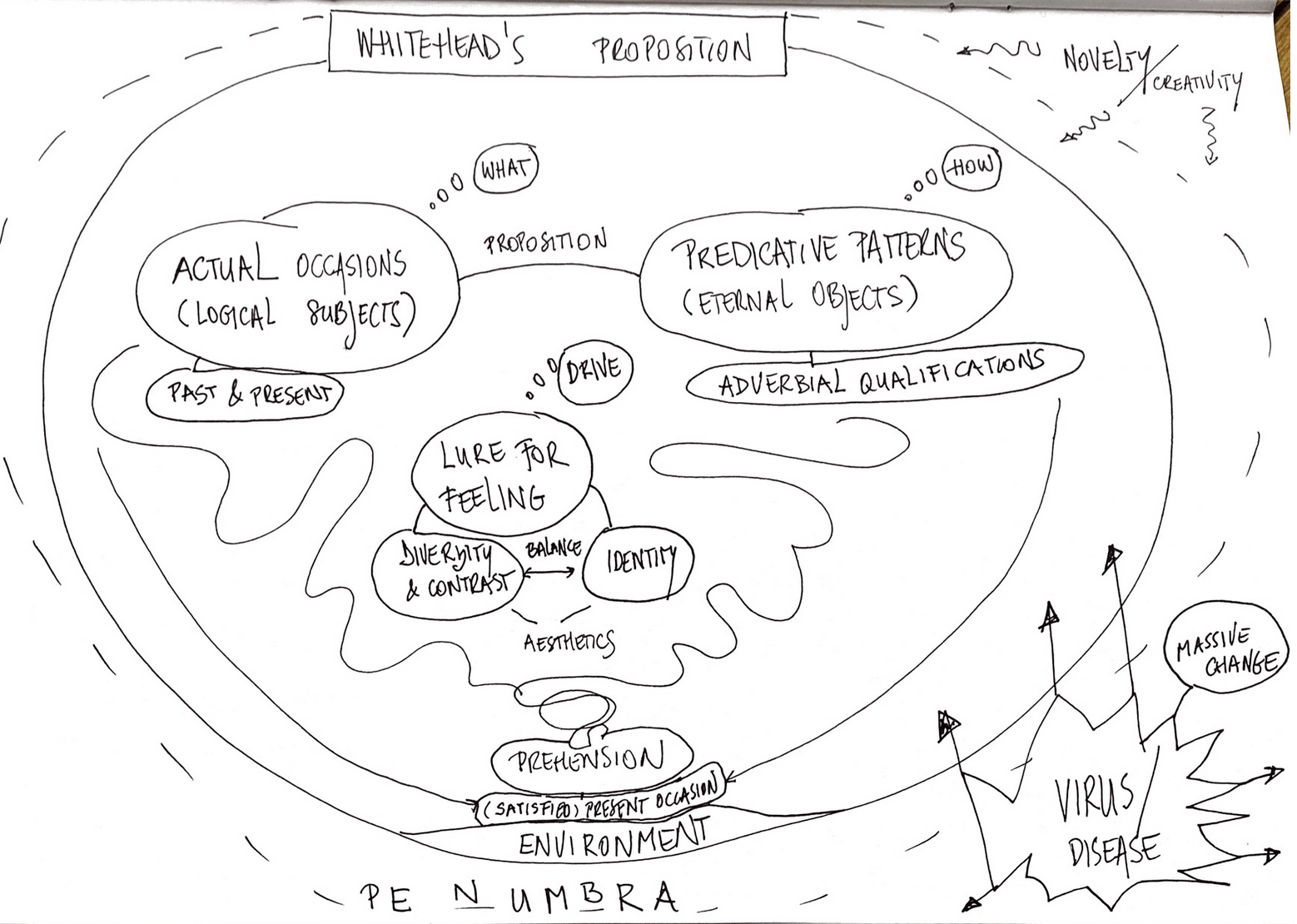
Reading: A.N. Whitehead. Process and Reality, Chapter IX: The Propositions
propositional #2 — 2019-09-26
Question: How to translate Whitehead's proposition into a generative worldbuilding toolkit? Proposition: A card game as a philosophical technique.
FoAM & CPT hosted a workshop exploring how to design a card deck which could clarify, generate and/or play with propositions (as described by Whitehead). These cards could be used in workshop situations, classrooms, futures sessions, policy labs, etc.
prototyping a game
Some ideas, principles, decisions, constraints, suggestions, open questions that emerged as we explored the propositions.
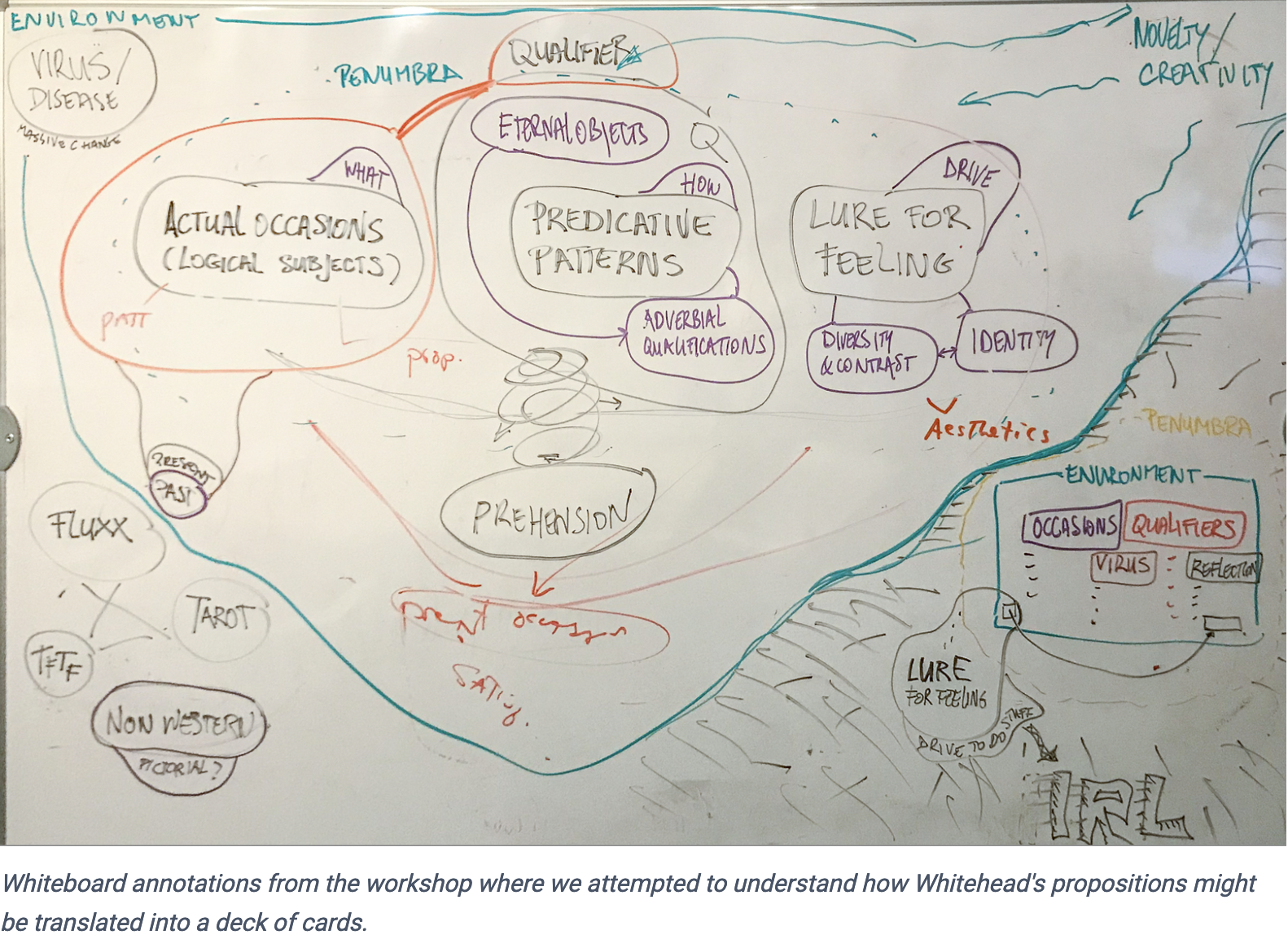
Design constraints
- Occasions exist in the past and/or present (but not in the future)
- It should be possible to play the game in different contexts, languages and cultures
- A game needs a starting point.
- …
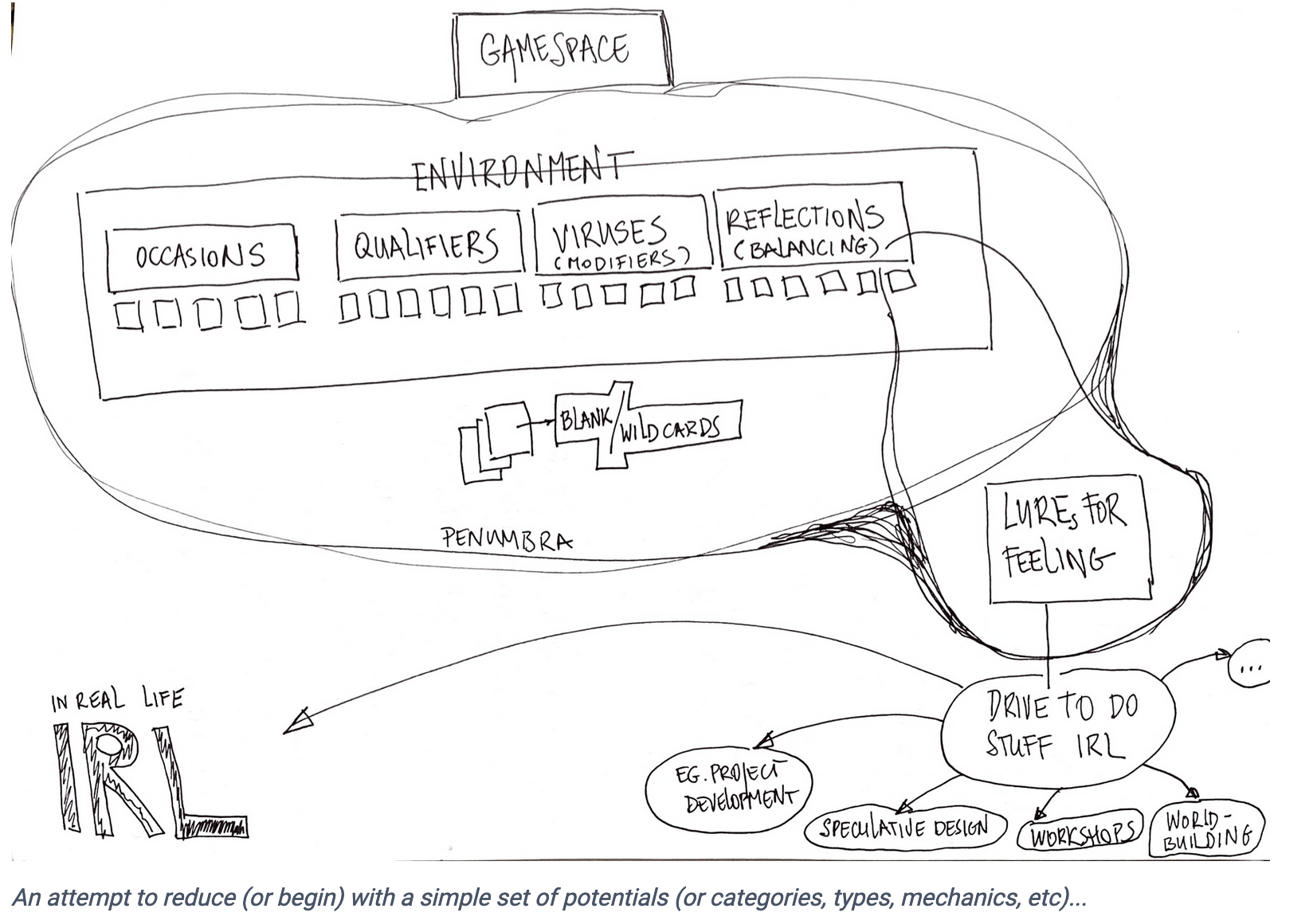
A proposition (P) requires an "actual occasion" (O) and a "predicative pattern" or "adverbial qualification" (Q) We tested the idea of a proposition (P) requiring two cards 1xO and 1xQ which are played as a single unit, which could be seen as "entertaining the proposition"
We tried using 2xO cards as a seed to begin the game. Some alternatives could be to use a minimal P (as a pair of 1xO and 1xQ), to decide collectively on a spread, or randomly choose cards for a starting point.
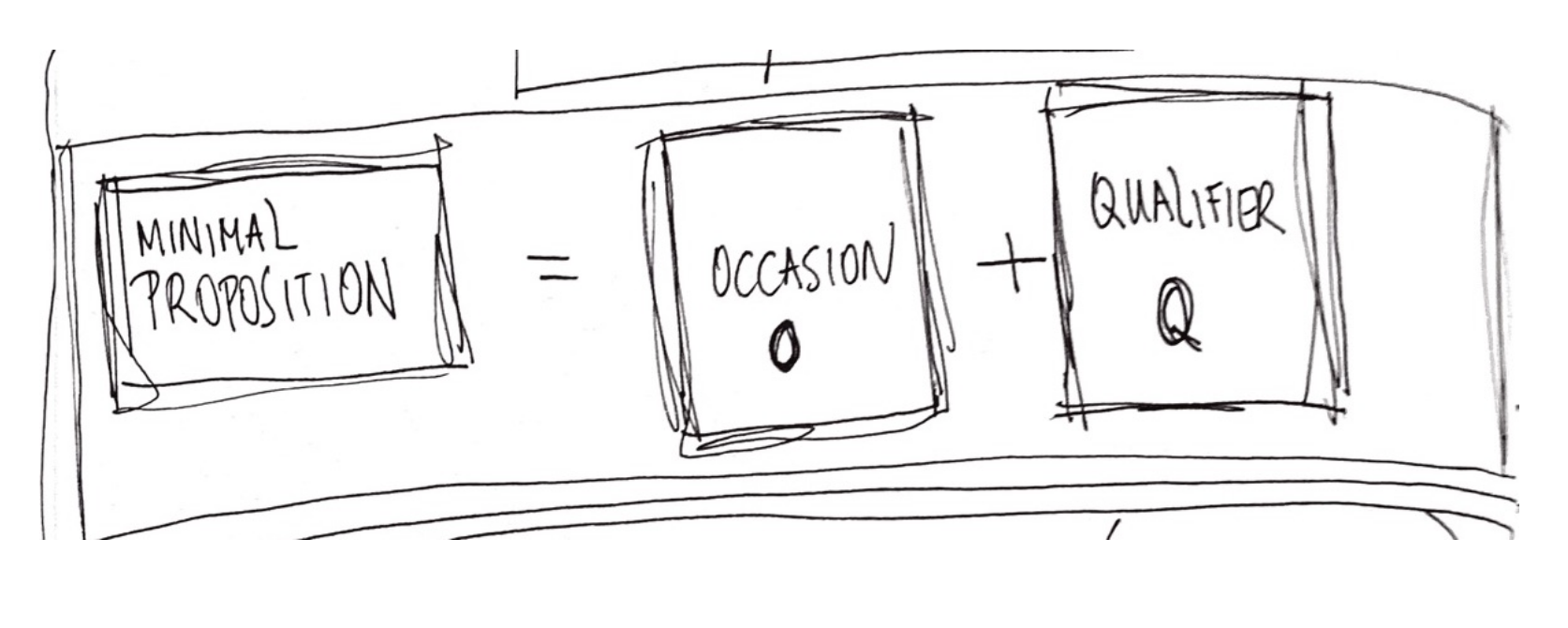
Possible categories of cards in the deck
- Occasions (actual occasions of experience)
- Qualifiers (predicative patterns/adverbial qualifications)
- Viruses (disruptive change, modifiers of the environment)
- Reflections (lures for worldbuilding/storytelling/IRL experiments)
- Blank cards/wildcards/jokers
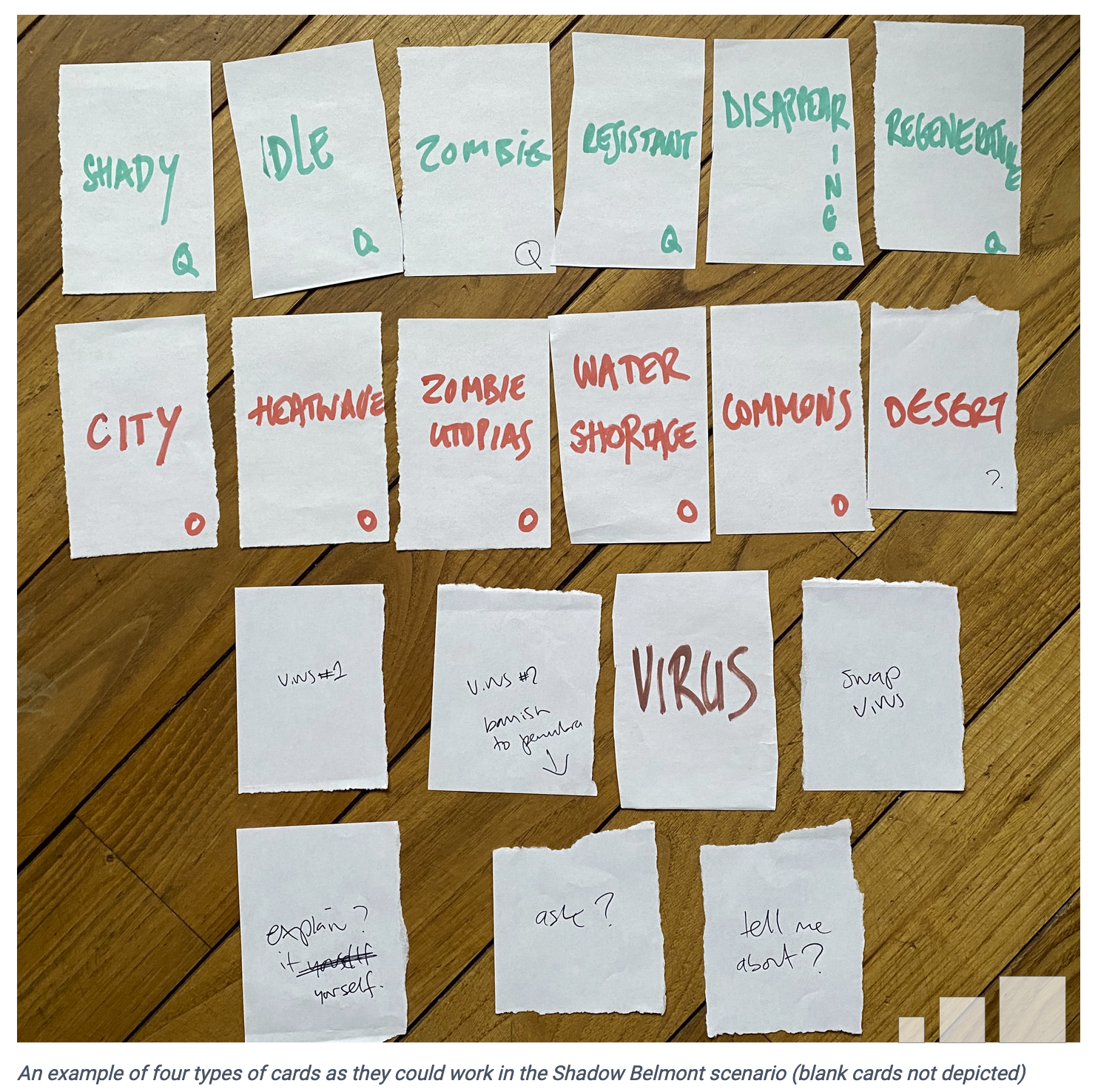
Possible game dynamics
How are cards distributed at beginning of the game? The deck could be divided evenly and completely between players (dealt randomly) or players can have one 'hand' at a time. (etc)
Cards are played in an 'Environment" (E). We thought it important that any P would modify the E directly in a way that effects the game. (i.e. each card played has an effect on the ’whole’ when it is played). Once a P is part of E is should persist and remain apparent.
Negative prehensions are placed in the "penumbra" (U).
Game dynamic #1: Prehending/entertaining propositions in an Environment
Once the starting point is established, players can add a P "below" any of the O cards currently in E. This can be either turn taking or out-of-order speed based play. A new P contains an O which is then becomes a new 'opening'.
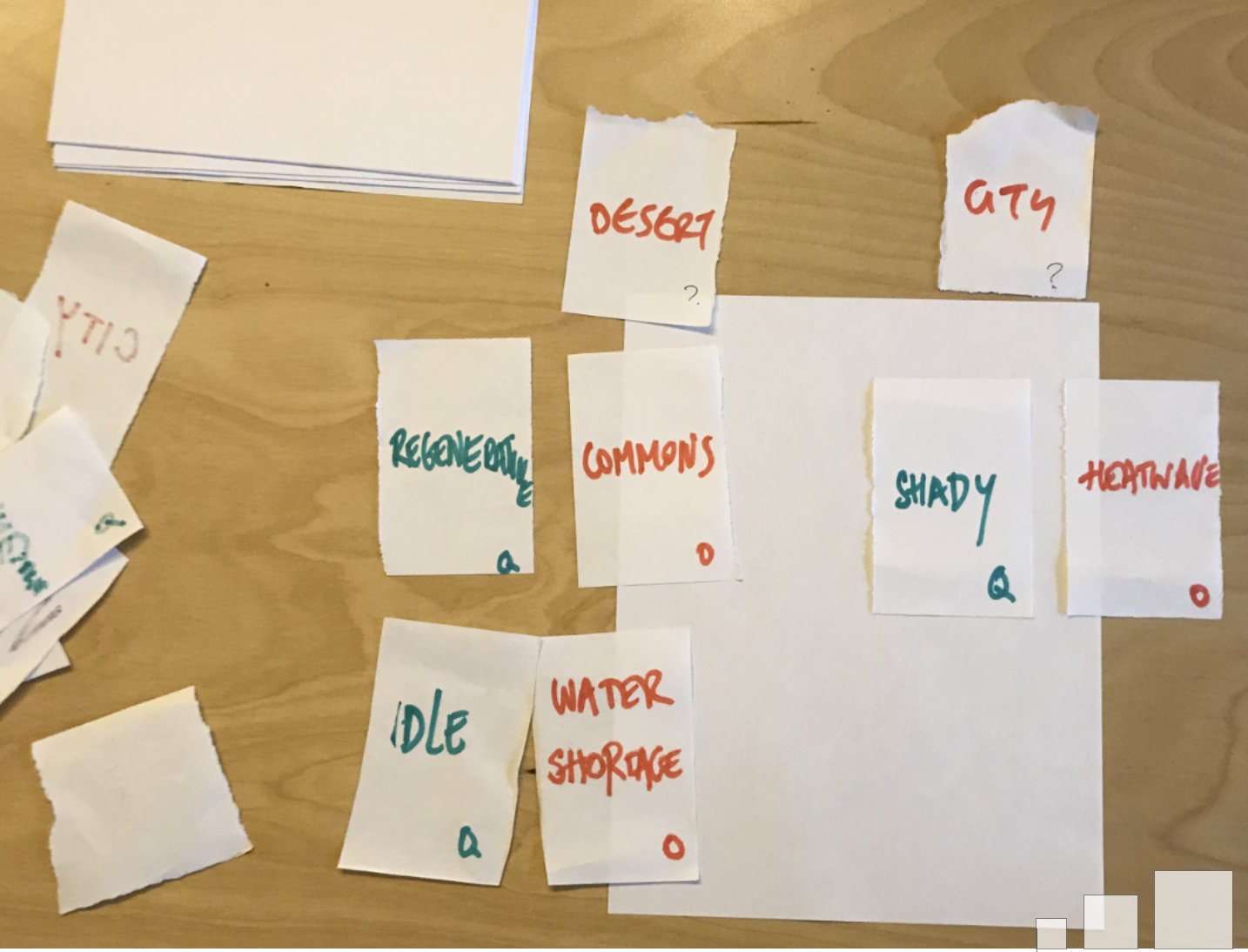
This appeared to create a game which could mindlessly perpetuate existing patterns., raising concerns about the role of storytelling, game play and collective/individual player's roles.
Game dynamic #2: Environment, Penumbra, Viruses (etc…)
- Prehension. Playing a Proposition (P=O+Q) alters the Environment (by "entertaining" or "prehending" the proposition, i.e. putting the cards "on the table")
- Adding multiple propositions (P) adds complexity to the environment (through accretion)
- Negative prehension. Moving one element of an unwanted proposition to the Penumbra (a space in which all cards continue to be available)
- Massive change to the environment can happen through "Modifier" cards or "Viruses".
- Different types of viruses can modify the environment in different ways by changing, moving or grouping cards
- Once the virus has modified the environment it moves itself to the Penumbra
- Novelty: We thought blank cards (wild/joker/temp) could be interesting (but haven't explored the ways they could work much).
more on Modifiers/Viruses
We thought that "virus" V cards are needed to cause disruptions or unexpected change. They can interact with all other cards in some way. This could be structural in that it changes the cards that are present in E for example, by moving cards from E into U (penumbra) swapping Q or O cards, etc. It could also be a way to change game play in various interesting, unpredictable ways.
This game dynamic seems to create a more complex game where the environment keeps growing, changing and collapsing. It isn't clear how this version of the game would end…
Game dynamic #3: Reflection/Storytelling
We agreed on the importance of including narrative or storytelling aspects. The Environment could acts as a prompt, or way of developing a scenario. To test how we could introduce this as part of the game play (rather than between rounds for example) we tested "reflection" cards (R) as a way to ask questions (which could be about the propositions, environment or players) and to tell stories.
A reflection card requires a player to explain, elaborate or describe the Proposition (we chose the most recently played, but could be applied to any other card, or branch in the Environment). This could involve the player who played the card, another player or all players. Various combinations of Reflection cards could prompt structured conversation around the various Propositions.
We entertained the possibly that the V and R cards could be merged, or that there could be another category that is not Propositions made from pairs of O and Q cards,
Game dynamic #4: The end?
We had some ideas (but did not reach any conclusions) about how the game could end. We would like to test ideas around 'keeping the game going' and finding points to use a scenario (as developed in E) as a prompt for further work IRL (cue the "mere matter of implementation" deck.)
Game dynamic summary: Some simple rules
- a Proposition P is composed of one Q card and one O card
- (details and the specific cards are still to be sketched…)
- A 'turn' is comprised of a single activity (play)
- valid actions are to play P, V or R in E; to play one P in U; or to swap one card from U into the players hand (or the unplayed deck?)
- a player can only play one P, V or R at a time (turn?)
- a P can be played in E or U (the Penumbra)
- a P played in E is appended to an 'active' O in a vertical sequence (an active O is one of the lower most…)
- the cards played in E are usually fixed and accrete.
- any cards played in U become available for other players and are messy (visible? layered?)
- one R or V card can be played at a time (turn?)
- a R card starts a process of reflection on one card or collection of cards in E (or possibly U?)
- e.g. a question about a P or a story about the present E, and could also include creative prompts…
- a player can swap one of their cards for a card in U
- […]
At this point, we still need to describe lures, iceberg tips of lures, the inside, outside or boundedness of a game, how it could be expanded, extend, situated, localised…
propositional #3 — 2020-09-17
These instruction emerged during a series of discussions, tests and design probes conducted mainly online from September to November 2020.
some ideas, reiterations, motivations and questions
The card or deck types can be “situated”, “archetypal” or “blank” we still think this is open, yet defined enough to be interesting and that cards, from different decks can be mixed, or merged as required.
play as an origin story of a shared world
As the game develops, lures for feeling can emerge and provide ways to blur gameplay and the “outside”
A proposition, or the process of realisation, or following a lure is not usually “instructional”
what makes a player move is the environment around them, driving play further rather than going toward the penumbra (as “negatively prehended”)
As the game is played there is an accumulation of cards and shifts in relevance between them.
how does time pass? (in the game and/or in Whitehead’s cosmology)
how does something “gain relevance”?
once a proposition is fulfilled an Q&O pair become ’actualised’, the proposition enters the ’actual world’ as a satisfied occasion.
parameters for how cards are related to things in the real world can be agreed upon at the outset (e.g. ecological, meal, etc… ) but the interpretation may change during the course of the game, and the relationships develop in unexpected directions.
an example the gameplay in a workshop context
…a workshop occurs as part of the world and a card game occurs as a part of the workshop with formal (explicit) relationships between cards and aspects of the outside world (still interior to the game)
round 0 (cards)
- start with an “actual world“ a pre-existing game state (created, discussed or random…)
- a way to establish the world in which you’re playing
- entertaining propositions (as gameplay)
round 1 (IRL or ”the wider realm“)
- Play a Q&O as an ’occasion’ to become ’actual’. actualise.
- actualising propositions (e.g. a meal) in game and ‘in the world’
- an ‘actualised proposition’ becomes a ’satisfied occasion’
- generate new O cards to bring to round 2.
round 2 (with cards)
- Q&O –actualised→ into a new ‘O ’
- after returning from the ’actualised occasion’ add Q cards to the new compound O (qualifiers of O as experienced)
- create new propositions: by adding O cards generated during round 1 to the Q cards played in this round. (alternatively: Play a Q&O as an ’occasion’ to become ’actual’. actualise. come back, add Q card to new O, generate more Os during dinner & play them)
round 3 (IRL or ”the wider realm“)
- choose a new proposition to actualise
- do it. (repeat round 1 & 2)
(how does this end?)
questions, realignment, reconfiguration, etc
- what provides the “lure”?
- what are the relationships between the “world of the game” and the “world of the game in the world” how are they made apparent?
- porous boundaries between speculation/actualisation and game(cards)/world(game) could be confusing or productive.
another attempt exploring possible game play
working from various ideas and minimal conditions (as above)
- there is a pack of cards and a place in which the game occurs
- the game can happen quickly, or last for several days using the same rules/gameplay
- there are O and Q cards and possibly R/V cards
- a ’minimal proposition’ is made up of a pair of cards, one O and one Q.
- the “deck“ is open ended, in that there isn’t a fixed number of cards, size of deck, some can be blank, etc
- there must be some explicit ’relationship’ or link between particular cards and things in the wider space of play.
- players agree on rules, relationships, duration, etc.
- the game has an impact on the people playing it and the place in which it happens
- the people playing, and place in which the game is played has an influence on how the game is played
- gameplay can encourage cooperation and/or conflict
- the game is “just” a game, yet always acts as a metaphor for the world in which is it played (?)
Ground assumption. The world is not a ’blank slate’ so game begins with some establishing process
- e.g. careful deliberation and selection of relevant pairs of O&Qs placed in play
- e.g. shuffle & randomly select an agreed upon number of pairs to start working with
Gameplay proposition
round 0
- establish duration, conditions for ending the game, ’way of beginning’
- establish relationships between cards & non-card world (should be fairly explicit)
- select pairs of O&Q cards to set the basis for the game (via deliberation, chance, etc+)
round 1 to n
- play some pairs (each player in turn, or collaboratively/collectively)
- a proposition (pair) is ’realised’ by being ’played’ (?) becoming a lure.
- the proposition (having a relationship to something ’outside’ the cards) becomes ’actualised’ (by doing something)
- having (done something) players return to the cards
- select new cards (pairs) based on their experience of the (something that has been done)
- player(s) can play Q card(s) on the ’actualised proposition’ (now treated an “occasion“?)
- layer, add, repeat
place a proposition…
[Q][O]
each player (or unit of players) adds a Q to the now (unified?) Q&O pair that was ’realised’.
[Q] [Q] O [Q]
adds O card(s) to test propositions
[O][Q]\ [Q]-O [Q]/
repeat
[Q]-Q\ [Q]-O [Q]/
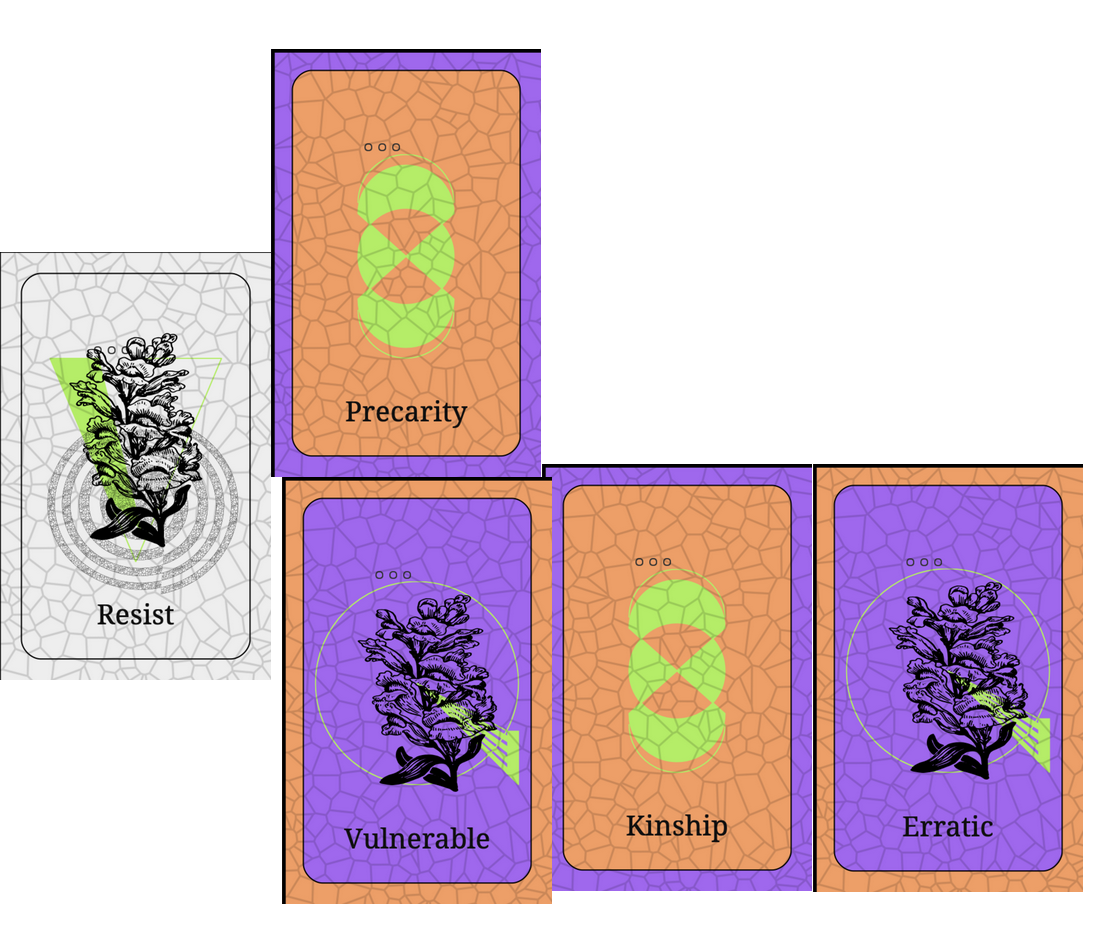
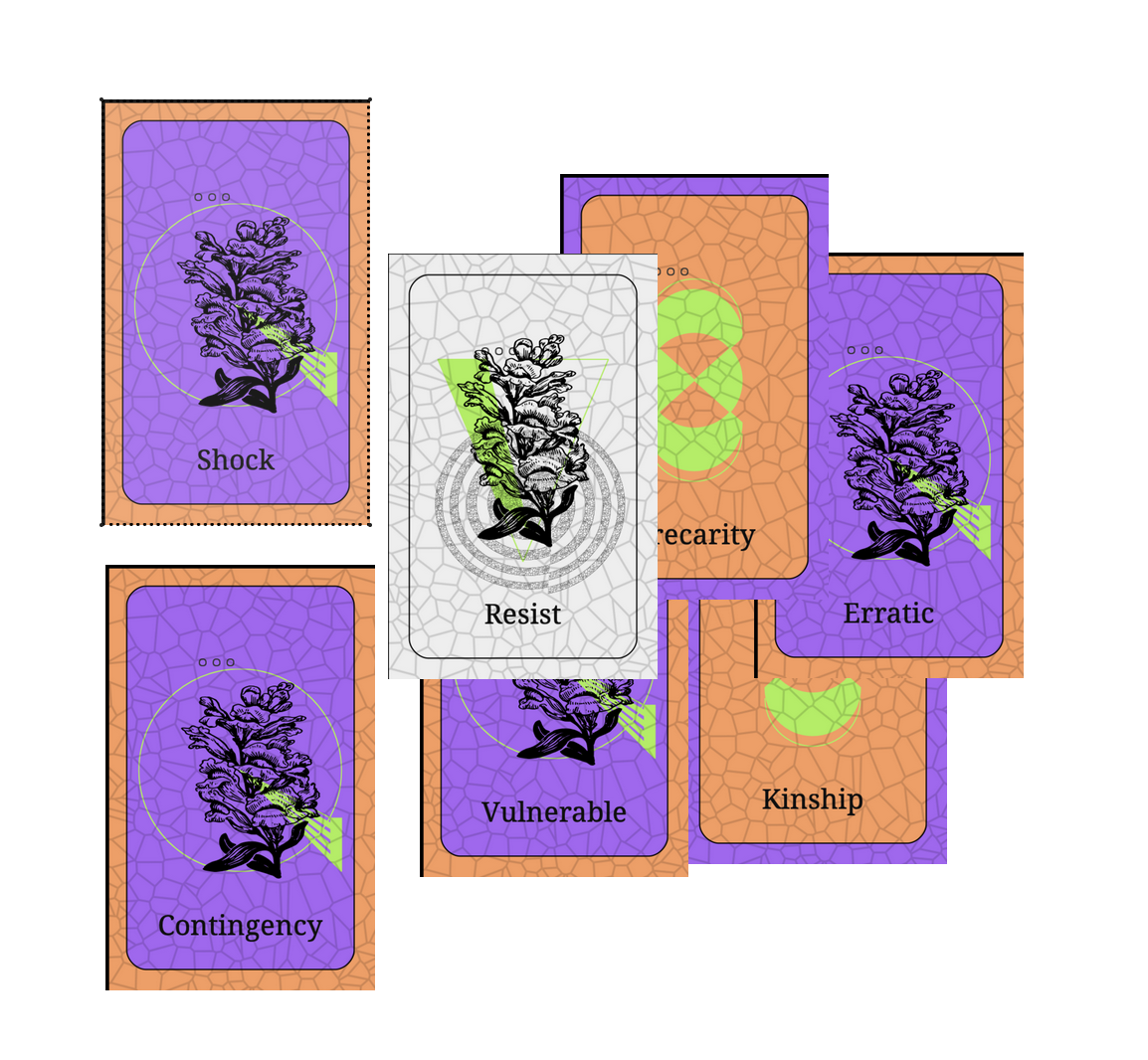
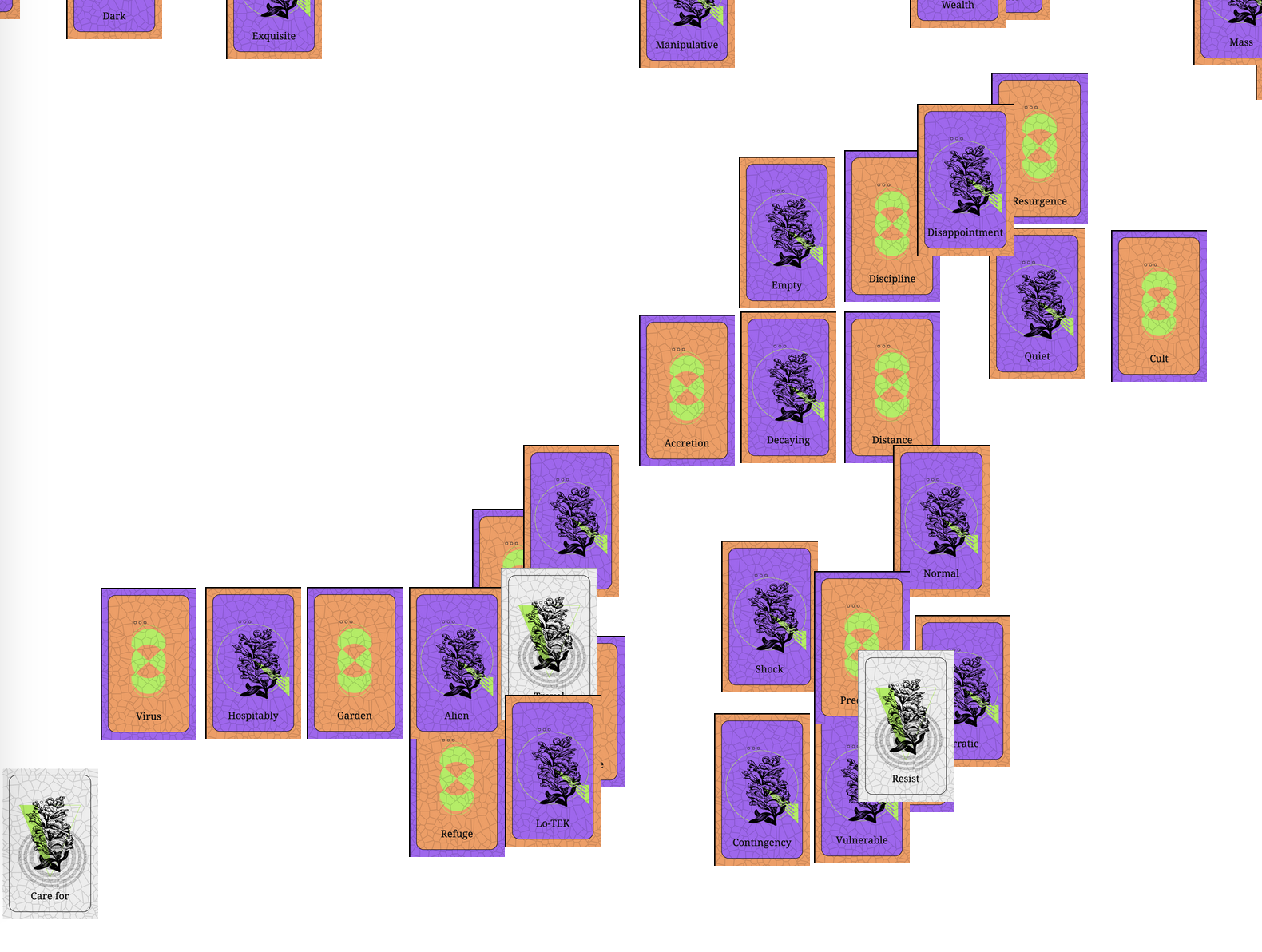
prototyping a ’situated deck’
On 2020-10-08 & 2020-10-22 we embarked upon some more specific game play tests using a situated ’pandemic’ deck for context. There are 3 types of cards, O,Q & V, each is labelled with a single word (in English) and there are consistent colours for each type of card.
We began with an extensive deck (of around 260 cards) in the expectation that some cards would work together in particular ways, and could suggest interesting directions for specific cards.
(an editable version of can be found at https://neon.fo.am/s/qjEeXnbFTznmpDj )
| occasions | qualifiers | verbs |
|---|---|---|
| Livingroom | Hostile | Cook |
| Computer | Malaise | Walk |
| Anxiety | Isolate | |
| Urban | Boredom | Test |
| Empty City | Frenzy | Avoid |
| Depleted Resources | Suffocating | Plan |
| Supplies | Paralyzed | Slow down |
| Mask | Desperate | Unplan |
| Hospital | Hospitably | Explore |
| ICU | Erratic | Play |
| Bed | Tedium | Transform |
| Sanitizer | Wastefully | Protect |
| Patio | Conservatively | Regenerate |
| Produce | Solidarity | Grow |
| Meat | Racist | Incubate |
| Canned Goods | Inequality | Mourn |
| Debate | Acedia | Repair |
| Fight | Fake | Destroy |
| Resistance | Interdependent | Create |
| Inertia | Shock | Travel |
| Truth | Normal | Bake |
| Vaccine | Authoritarian | Trick |
| Hoax | Hybrid | Break |
| Internet | Postal | Move |
| Connection | Care | Build |
| Disconnection | Life | Assemble |
| Conspiracy | Fool | Dissolve |
| Cult | Young | Embody |
| Meme | Ageing | Enact |
| Space race | Confined | Prototype |
| Idiocracy | Belonging | Ferment |
| Slowdown | Satiated | Distill |
| Distance | Lassitude | Adjust |
| Transition | Overwhelmed | Defeat |
| Social contract | Listless | Make |
| UBI | Calm | Exchange |
| Blockchain | Critical | Gather |
| Privacy | Vital | Care for |
| Conspiracy | Erratic | Amplify |
| Science | Regulated | Remember |
| Illness | Desire | Question |
| Border | Freedom | Stockpile |
| Therapy | Sacrifice | Reinforce |
| Rule | Power | Prepare |
| Path | Sufficiency | Change |
| Quarantine | Altruistic | Distort |
| Survival | Pressure | Reverse |
| Cult | Grief | Decorate |
| Rebellion | Destructive | Judge |
| Self | Infectious | Solve |
| Loss | Warm | Resist |
| Ruin | Fever | Reduce |
| Forest | Greed | Search |
| Desert | Ambiguous | Display |
| Ocean | Progressive | Maintain |
| Swamp | Social | Remove |
| Bread | Swarm | Infect |
| Heatwave | Mass | Rethink |
| Wound | Manipulative | Worship |
| Movement | Disappointment | Influence |
| Protest | Climate | Compose |
| Separation | Safe | Curate |
| Justice | Decaying | Cure |
| Crisis | Dark | Predict |
| Experiment | Gratitude | Entangle |
| Death | Resilient | Nurture |
| Abundance | Vulnerable | Track |
| Friendship | Sorrow | Describe |
| Kinship | Futile | Visualize |
| Change | Interference | Sketch |
| Livelihood | Cruel | Merge |
| Politics | Happy | Design |
| Accretion | Wealth | Cultivate |
| Voice | Depression | Abandon |
| Discipline | Quiet | Disinfect |
| Garden | Empty | Engage |
| Water | Essential | Overthrow |
| Air | Suspicion | Reflect |
| Earth | Exquisite | Contemplate |
| Fire | Comfort | Tinker |
| Virus | Sick | Organize |
| Bushcraft | Post-traumatic | Evolve |
| Refuge | Lo-TEK | Escape |
| Ice | Alien | Alleviate |
| Decay | Liminal | Perform |
| Resurgence | Contingency | Experiment |
| Precarity | Environmental | Experience |
propositional #4 — 2020-10-14
continuing from previous tests with the pandemic situated deck…
(expand: rounds, cycles, introduction of "verbs". expanding and joining propositions [OQ] and spatial layout)
First cycle (establishment)
- setting parameters for the game
- spread - tarot like for the individual (mechanical/chance) or
multiplayer (agree collaboratively how it could work)
- (deliberation in a multiplayer situation) - determining the stakes, this is the scope of the game, these are the connections, these are the rules…
- one position in the spread → a situation in the wider realm
- what might be the other positions?
- what is the current situation? each player is dealt an occasion card and you can pick a qualifier to describe the current situation. all occasions exist - place them closer to the centre if they describe the situation, put them further away to the edge of the environment if less relevant
- the environment has a centre and periphery (spatial architecture matters). first round - describing the current situation, next rounds - what's in the centre has been actualised
- after everyone has put down a proposition i.e. O+Q cards (that describe the current situation), one verb card is played (a lure to intervene in the current situation) - either random (as a constraint), or chosen (because the player(s) agree that this action is a good lure?)
Second cycle (continuation)
- Round 1: everyone adds a qualifier to the propositions in the environment (either to one proposition or to connect two propositions → propositions that shouldn't connect, connect → depth of satisfaction). the qualifier should make it more appealing to entertain the propositions in the wider realm.
- Round 2 (,3,4,5,n): everyone can play either a
qualifier or an occasion on the propositions that are in the environment
- after the 2nd round the players can discuss if they want to play the verb on a proposition and go actualise it in the wider realm. if they're insufficiently 'lured' they play another round (Q/O cards)
- alternatively → any player can BECOME GOD - choose to play the verb that is already in the environment and add it to a proposition, in whichever round (if the player has an idea how the proposition could be actualised). the other players can discuss.
- the players decide how to actualise the proposition and go and do this in the wider realm. if they are satisfied they can decide to end the game. otherwise they come back to the card game for the next cycle
- The propositions that are not going to be actualised in this cycle move into the penumbra.
Third cycle
- Round 1: the actualised proposition now becomes an
occasion.
- players add qualifiers to this occasion based on their experience of actualising it in the wider realm
- a new verb card is given/chosen
- Round 2 (,3,4,5,n) - the same process as in the
Second Cycle (playing occasions or qualifiers until the verb is added to
a proposition.
- a player can decide to bring a proposition from the first round back from the penumbra and entertain it in the environment again with a different verb.
- as the propositions get more complex (if multiple rounds are played), things at the end of a chain are more prominent for the actualisation.
- After the proposition is actualised in the wider realm, the players decide to either stop (satisfied) or continue for another cycle.
Questions
When does the discussion about duration of play happen (i.e. how many cycles will be played)?
The game can end in a few different ways
- after any actualisation in the wider realm by agreement of the players (end of a 'cycle')
- after all (verb) cards are exhausted (or all qualifiers/occasions) (end of the deck)
- or it's open-ended, or end of a workshop, or all players satisfied… (ongoing…)
- the players can agree on how they want the game to end beforehand (pre-determined)
…and 2020-10-28
for next time:
- clean up the notes for game mechanics
- decide how to start the game (try out different ways)
- clean up the word lists - situated (pandemic) + archetypal
- empty deck, printable decks, deluxe printed decks (with images), programmable e-paper deck
…and 2020-11-11
- tested the ’chance’ and ’deliberation’ modes of play. both appear potentially interesting…
- working title becomes ’superject’ (rather than S.P.A.C.E)
There was some discussion about reintroducing ‘virus’ and/or ways of changing the physical layout of the Environment as the game progresses, and there may be ‘too many’ cards in play. how could something like an ’abstraction” process work? how can these ’modifier’ cards be introduced? at points of frustration? by chance? and possibly acting over longer game cycles (if a modification takes effect over several rounds, etc+). Modifiers could remain face down → selected at points of inflection during the game.
Following the game flow as outlined in the diagram (ref.) raised a question about when the V cards introduced. is it part of the starting cycle (cycle0) or the ongoing cycles? are they chosen with, or after the initial P or with the first round of qualifiers?
For example, during the opening ’deliberation’ cycle…
- each player chooses one card (O or Q) and places in E
- discuss amongst, between, etc
- aim is to describe the ’current situation’ something like a check-in round
- place matching cards to create P in E
- decide collectively on relevant V cards (a suitable number of V cards for expected length of the game)
The glossary has been transferred to subetha (at superject)
design notes
online and automated
In thinking about how image centric cards could work, we tested a few
methods of automating image selection for the pandemic deck. the squib script now includes an option to add
images from searches based on the description of the card.
- text2image generates an image from the card’s “name” using a GAN
- unsplash can be used to search for photographic images
- pelxels for clipart search (not guaranteed to provide a match)
…and a first pass at an online interface (using deck-of-cards)

…some cards are more humorous than useful, but could open other directions and/or serendipity.

decks & directions
We agreed to create two prototype decks. One archetypal and one deck “situated” in the pandemic
card design directions, elucidations, dilapidation…
- abstract ⟷ figurative
- sparse ⟷ elaborate
- playing cards ⟷ blank cards
- consistent style ⟷ variety of style
elements to consider
- obvious differentiation of types of cards (O,Q,L) colour, symbols, icons, type, etc.
- words
- images
- template for fixed elements & generative layout
…and 2020-11-18
extracted from superjected and continued
a glossary (The Fallacy of Misplaced Concreteness)
A description of terms which may be particular to Whiteheads cosmology and terms which are used in a specific way in the game
Cards:
- Occasions
- (Qualifiers) -> Eternalities, Potentialities, Emotions -> needs a different name (ADAM TO CHECK IN WHITEHEAD'S LATER WORK.)
- Lures
- Life/vitality? As a separate type of card or as part of occasions/lures/qualifiers?
Spaces (gradients, able to change shape and permeate parts of each other as propositions are entertained/satisfied)
- Locus (was Environment)
- Penumbra
- Wider realm (?)
(Concrescent) Phases
- Conformal (starting cycle, first cycle after a proposition is satisfied in the wider realm)
- Non-conformal (second, third, n-th cycle where the alternative propositions are entertained - creation of novelty)
Life-cycle of occasions, the genealogy, time stream for the online version (over the whole game or multiple games, tracked and played as animation at the end)
Good quotes, maybe integrate somewhere…
"The concrescence, absorbing the derived data into immediate privacy, consists in mating the data with ways of feeling provocative of the private synthesis. These subjective ways of feeling are not merely receptive of the data as alien facts; they clothe the dry bones with the flesh of a real being, emotional, purposive, appreciative" (PR, 85)
"The creative process is rhythmic: it swings from the publicity of many things to the individual privacy; and it swings back from the private individual to the publicity of the objectified individual" (151).
A summary
"Thus the actual entity, as viewed morphologicaIIy through its 'satisfaction,' is novel in reference to anyone of its component feelings. It presupposes those feelings. But conversely, no feeling can be abstracted either from its data, or its subject. It is essentiaIIy a feeling aiming at that subject, and motivated by that aim. Thus the subjective form embodies the pragmatic aspect of the feeling; for the datum is felt with that subjective form in order that the subject may be the superject which it is" (233).
- Proposition (game, process, etc)
- Occasion (and "Actual occasions" or “Occasion of experience”)
"Actual entities' -also termed 'actual occasions' -are the final real things–, of which the world is made up" (PR, 18).
Qualifier (card) a “predicative pattern” or "eternal object" of an occasion needs a new name. (some suggestions -> "Eternalities", "Potentialities", "Predicates", Emotions - none of them seem quite right)
what is it?
"that which overflows"
potential for relation
something raw, visceral to add to "facts" (clothing on alien bones)
horror, relief and purpose are the primary feelings when entertaining propositions. they exist in different intensities (rather than separate categories). we could use them as filters when designing the cards.
a Verb (card) -> "Lure"
The Wider Realm -> might need a new name.
(suggestion the “actual world” but it's too dry and perhaps not the correct term for this)
to actualise a proposition (an event) and satisfaction as completion…
Prehension and Negative prehension (etc)
"Each actual entity is 'divisible' in an indefinite number of ways, and each way of 'division' yields its definite quota of prehensions" (PR, 19).
"Actual entities involve each other by reason of their prehensions of each other. There are thus real individual facts of the togetherness of actual entities, which are real, individual, and particular, in the same sense in which actual entities and the prehensions are real, individual, and particular" (PR, 20).
"A negative prehension holds its datum as inoperative in the progressive concrescence of prehensions constituting the unity of the subject" (23-24).
"A negative prehension is the definite exclusion of that item from positive contribution to the subject's own real internal constitution. This doctrine involves the position that a negative prehension expresses a bond" (41).
"The actual entity terminates its becoming in one complex feeling involving a completely determinate bond with every item in the universe, the bond being either a *positive or a negative prehension" (44).
- The Environment (game) -> "Locus"
"The character of an actual entity is finally governed by its datum; whatever be the freedom of feeling arising in the concrescence, there can be no transgression of the limitations of capacity inherent in the datum. The datum both limits and supplies. It follows from this doctrine that the character of an organism depends on that of its environment" (110).
The Penumbra (game)
A lure for feeling (transmute) emotions, purposes, valuations, adversions, and aversions
"It is an essential doctrine in the philosophy of organism that the primary function of a proposition is to be relevant as a lure for feeling"
The 'lure for feeling' is the final cause guiding the concrescence of feelings (185).
- God as an eternal lure who wants to bring about the greatest possibility of satisfaction. -> Evocateur of Intensity
- etc
There is no going behind actual entities to find anything more real. They differ among themselves: God is an actual entity, and so is the most trivial puff of existence in far-off empty space. But, though there are gradations of importance, and diversities of function, yet in the principles which actuality exemplifies all are on the same level (18).
"The primary element in the 'lure for feeling' is the subject's prehension of the primordial nature of God" (189).
"The primordial nature of God is the acquirement by creativity of a primordial character" (344).
"He is the lure for feeling, the eternal urge of desire. His particular relevance to each creative act, as it arises from its own conditioned standpoint in the world, constitutes him the initial 'object of desire' establishing the initial phase of each subjective aim" (344).
- a superject -> becoming a satisfied occasion that becomes data for another world to concrese (concresence as a process, of infinite prehensions. conclusion)
The ultimate attainment is 'satisfaction.' This is the final characterization of the unity of feeling of the one actual entity, the 'superject which is familiarly termed the 'subject' " (166).
"This process of the integration of feeling proceeds until the concrete unity of feeling is obtained" (211).
" Self-realization is the ultimate fact of facts. An actuality is self-realizing, and whatever is selfrealizing is an actuality. An actual entity is at once the subject of selfrealization, and the superject which is self-realized" (222).
"An actual entity considered in reference to the publicity of things is a 'superject'; namely, it arises from the publicity which it finds, and it adds itself to the publicity which it transmits" (289).
maybe
- Propositional Feelings
"When an actual entity belongs to the locus of a proposition, then conversely the proposition is an element in the lure for feeling of that actual entity. If by the decision of the concrescence, the proposition has been admitted into feeling, then the proposition constitutes what the feeling has felt" (185).
"A proposition has neither the particularity of a feeling, nor the reality of a nexus. It is at datum for feeling, awaiting a subject feeling it. Its relevance to the actual world by means of its logical subjects makes it a lure for feeling. In fact many subjects may feel it with diverse feelings, and with diverse sorts of feelings. The fact that propositions were first considered in connection with logic, and the moralistic preference for true propositions, have obscured the role of propositions in the actual world" (259).
- Concrescence and Time
- Societies and Empty Space
- Perpetual Perishing
- Initial Aim
"This subjective aim is not primarily intellectual; it is the lure for feeling. This lure for feeling is the germ of mind. Here I am using the term 'mind' to mean the complex of mental operations involved in the constitution of an actual entity" (85)
- Intensity
"What is inexorable in God, is valuation as an aim towards order'; and order' means society permissive of actualities with patterned intensity of feeling arising from adjusted contrasts"(244).
"This 'aim at contrast' is the expression of the ultimate creative purpose that each unification shall achieve some maximum depth of intensity of feeling, subject to the conditions of its concrescence" (249).
“the novelty [introduced by a nonconformal proposition] may promote or destroy order; it may be good or bad. But it is new, a new type of individual and not merely a new intensity of individual feeling” (187).
“Existence, in its own nature, is the upholding of value intensity” (Modes of Thought, 111).
“The primordial appetitions which jointly constitute God’s purpose are seeking intensity, and not preservation. Because they are primordial, there is nothing to preserve. He, in his primordial nature, is unmoved by his love for this particular, or that particular. . . . In the foundations of his being, God is indifferent alike to preservation and to novelty. He cares not whether an immediate occasion be old or new. . . . His aim is for depth of satisfaction” (PR, 105).
“God’s purpose in the creative advance is the evocation of intensity. The evocation of societies, is purely subsidiary to this absolute end” (PR, 105). Meaning: God cares nothing for "humans" in themselves since humans are nothing but "societies"
Durations
Superject
Unity of Feeling
Life: robbery, alien, empty space, anti-social. An organism has life in it. Too much life = cancer.
a few excerpts from Chapter IX: The Propositions
"A living occasion is characterised by a flash of novelty among the appetitions of its mental pole. Such 'appetitions" i.e., 'conceptual prehensions' can be 'pure' or 'impure'. (…) The datum of a pure conceptual prehension is an eternal object; the datum of an impure prehension is a proposition, otherwise termed a 'theory'"
"In a physical purpose the subjective form has acquired a special appetition –adversion or aversion– in respect to that eternal object as a realized element of definiteness in that physical datum."
"It is evident, however, that the primary function of theories is as a lure for feeling, thereby providing immediacy of enjoyment and purpose. "
"Thus in our actual world of today, there is a penumbra of eternal objects" (note: layout-wise -> does this mean that all the qualifiers should be placed in the penumbra to start with (in a (semi) circle), while the occasions are placed in the environment (in a pile or smaller semi-circle)? (both can be either face up or face down) ) "the possibilities of another course of history"
"penumbra of alternatives" "penumbral welter of alternatives" (note: in the game - while we're coming up with the propositions, we're playing in the penumbra, until we decide to satisfy (some of) the propositions in the wider realm. they then become part of the environment (actual world). the propositions that we don't satisfy move further into the penumbra as alternatives. can the unsatisfied propositions in the penumbra ever be played back in the environment? in the layout of the game the penumbra is more like a gradient, and the environment (in the centre) changes shape to incorporate parts of the penumbra with the propositions that have been satisfied. right?)
"The elements of this penumbra are propositional prehensions, and not pure conceptual prehensions.
"Thus an element in this penumbral complex is what is termed a 'proposition'. A proposition is a new kind of entity. It is a hybrid between pure potentialities and actualities. A 'singular' proposition is the potentiality of an actual world including a definite set of actual entities in a nexus of reactions involving the hypothetical ingression of a definite set of eternal objects."
"The definite set of actual entities involved are called 'the logical subjects of the proposition'; and the definite set of eternal objects involved are called 'the predicates of the proposition'. The predicates define a potentiality of relatedness for the subjects. The predicates form one complex eternal object: this is the 'complex predicate'. The 'singular proposition' is the potentiality of this complex predicate finding realization in the nexus of reactions between the logical subjects, with assigned stations in the pattern for the various logical subjects."
"… every proposition must be somewhere. The 'locus' of a proposition consists of those actual occasions whose actual worlds include the logical subjects of the proposition. When an actual entity belongs to the locus of a proposition, then conversely the proposition is an element in the lure for feeling of that actual entity. "
"… the main function of propositions in the nature of things. They are not primarily for belief, but for feeling at the physical level of unconsciousness. They constitute a source for the origination of feeling which is not tied down to a mere datum. A proposition is 'realized' by a member of its locus, when it is admitted into feeling. "
"There are two types of relationship between a proposition and the actual world of a member of its locus. The proposition may be conformal or non-conformal to the actual world, true or false.
When a conformal proposition is admitted into feeling, the reaction to the datum has simply resulted in the conformation of feeling to fact, with some emotional accession or diminution, by which the feelings inherent in an alien fact are synthesized in a new individual valuation. (note: first cycle of the game, where the 'members of the locus of a proposition' establish a 'new individual valuation' of their 'actual world' ? + the cycle that comes after a proposition was satisfied in the wider realm. )
When a non-conformal proposition is admitted into feeling, the reaction to the datum has resulted in the synthesis of fact with the alternative potentiality of the complex predicate. A novelty has emerged into creation. The novelty may promote or destroy order; it may be good or bad. But it is new, a new type of individual, and not merely a new intensity of individual feeling. That member of the locus has introduced a new form into the actual world; or at least an old form in a new function. " (note: the second cycle, where the 'members of the propositional locus' come up with propositions that can provide alternatives to the 'datum' / 'actual world')
"in their primary role they pave the way along which the world advances into novelty. Error is the price which we pay for progress."
"Judgement is the decision admitting a proposition into intellectual belief"
"In considering the life-history of occasions, forming the historic route of an enduring physical object, there are three possibilities as to the subjective aims which dominate the internal concrescence of the separate occasions. (note: something to consider for multiple rounds, when we satisfy propositions into occasions? history, geneology, traces of how O@Q cards have been played together. and which lures have been played )
Either:
(i) the satisfactions of the antecedent occasions may be uniform with each other, and each internally without discord or incitement to novelty. In such a case, apart from novel discordance introduced by the environment, there is a mere conformal transformation of the feeling belonging to the datum into the identical feeling belonging to the immediate subject. Such pure conformation involves the exclusion of all the contraries involved in the lure, with their various grades of proximity and remoteness. This is an absolute extreme of undifferentiated endurance, of which we have no direct evidence. In every instance for which we can analyse (…) the formal constitutions of successive occasions, these constitutions are characterised by contraries supervening upon the aboriginal data, but with a regularity of alternation which produces stability in life-history. Contrast is thus gained. In physical sciences, this is 'vibration'. This is the main character of life-histories of an inorganic physical object, stabilised in type.
(ii) there is a zest for the enhancement of some dominant element of feeling, received from the data, enhanced by decision admitting non-conformation of conceptual feeling to other elements in the data, and culminating in a satisfaction transmitting enhancement of the dominant element by reason of novel contrasts and inhibitions. Such a life-history involves growth dominated by a single final end. Such physical objects are mainly 'organic' so far as concerns our present knowledge of the world. (PR 187,188)
(iii) there is a zest for the elimination of all dominant elements of feeling, received from the data. In such a case, the route soon loses its historic individuality. It is the case of decay."
"The admission of the selected elements in the lure, as felt contraries, primarily generates purpose; it then issues in satisfaction; and satisfaction qualifies the efficient causation. But a fe;t 'contrary' is consciousness in germ. When the contrasts and identities of such feelings are themselves felt, we have consciousness."
"The presupposed logical subjects may not be in the actual world of some actual entity. In this case, the proposition does not exist for that actual entity. The pure concept of such a proposition refers in the hypothetical future beyond that actual entity. The proposition itself awaits its logical subjects. This propositions grow with the creative advance of the world. They are neither pure potentials nor pure actualities; they are a manner of potential nexus involving pure potential and pure actualities. They are a new type of [impure] entities."
"The primary mode of realization of a proposition in an actual entity is not by judgement but by entertainment. A proposition is entertained when it is admitted into feeling. Horror, relief, purpose, are primarily feelings involving the entertainment of propositions."
"There are four main types of entities in the universe, of which two are primary types and two are hybrid types. The primary types are actual entities and pure potentials (eternal objects); the hybrid types are feelings and propositions (theories). Feelings are the 'real' components of actual entities. Propositions are only realizable as one sort of 'objective' datum for feelings.
The primary element in the 'lure for feeling" is the subject's prehension of the primordial nature of God. Conceptual feelings are generated, and by integration with physical feelings a subsequent phase of propositional feelings supervenes. The lure for feeling develops with the concrescent phases of the subject in question. (…) It is this realized extension of eternal relatedness beyond the mutual relatedness of the actual occasions which prehends into each occasion the full sweep of eternal relatedness. I term this abrupt realisation the 'graded envisagement' which each occasion prehends into its synthesis. This graded envisagement is how the actual includes what (in one sense) is 'not being' as a positive factor in its own achievement. It is the source of error, of truth, of art, of ethics, and of religion. By it, fact is confronted with alternatives."
"There is a togetherness of the component elements in individual experience. This 'togetherness' has that special peculiar meaning of 'togetherness in experience'. It is a togetherness of its own kind, explicable by reference to nothing else."
…and 2020-11-25
Key strands for the coming month:
- Describe the project (text and image(s))
- Prototype two decks (archetypal and situated) and instructions
- Test prototype game with others
- Develop ideas for visual style, graphic elements (collect examples, feedback from players, cont. sketches)
- Prototype generative system (cont. )
improve the instuctions
and 2021-02-09
via adam
»
Superject is an experiment. It is an experiment that is bold and humble at the same time. It mixes philosophy and design but is neither one of them. Philosophers would certainly object that Superject is not philosophy, while designers would likely balk at its many metaphysical conceits. It weaves philosophy and non-philosophy, or perhaps better: design and non-design; but then again, this experiment is not particularly interested in knowledge hierarchies. Alternatively, we could say that mixing philosophy and design creates an emergent species, something altogether different and unrecognizable, but then what of its components? Maybe it’s better not to worry about the dialectical essence of Superject and simply focus on its appearance: it’s a game.
other games, gameplay and/or narrative tangents
Looking at various cards, decks and games in an attempt understand our possibility space, focus and intent, through the lens of Whitehead's propositions….
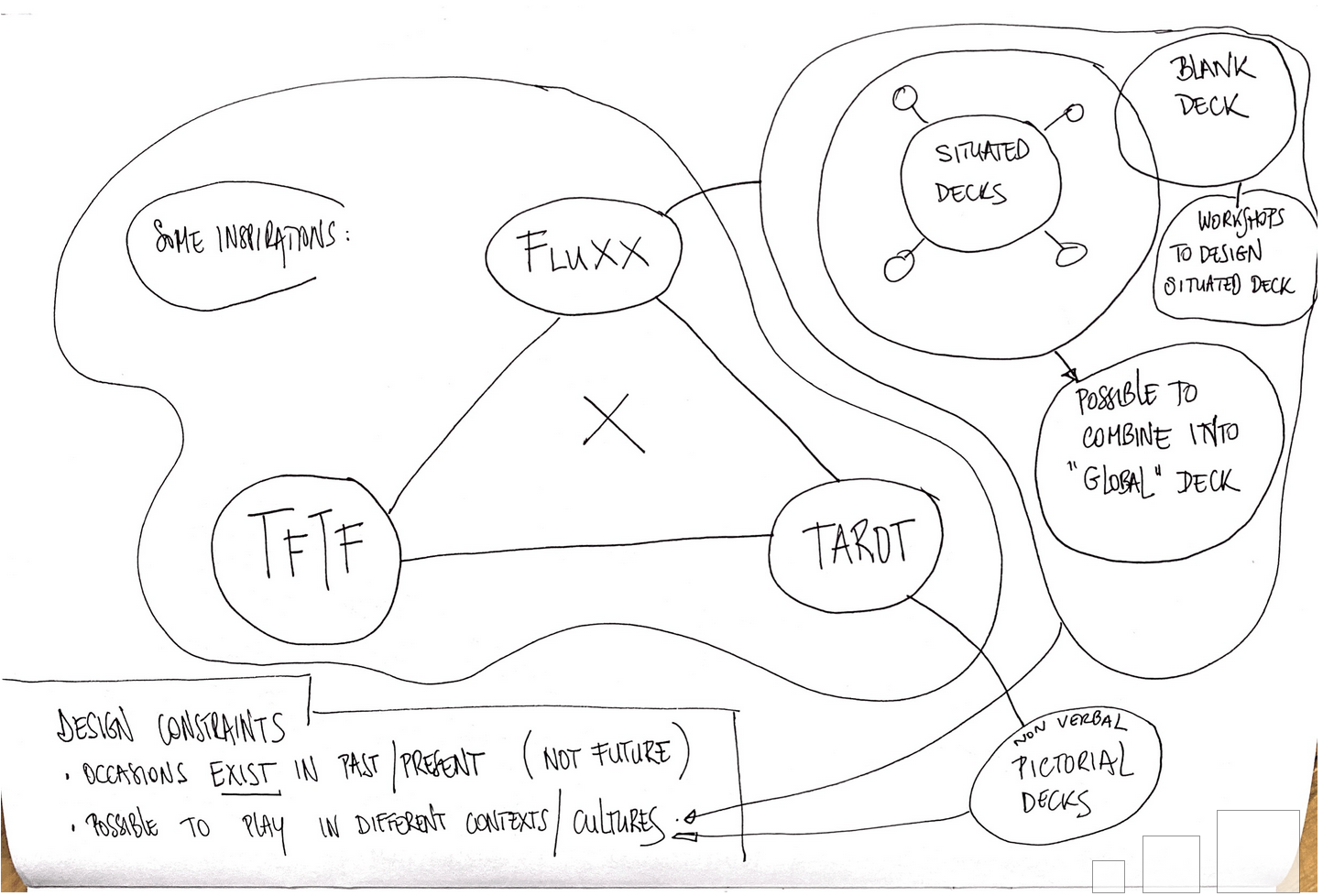
some examples, an attempt at taxonomy and cartomancy (game like rules → games with an outside?)
Tarot
- Tarot tutorial (libarynth)
- combinatorial, graphic, fixed symbolism/archetypes, open grammar, spatial → context/interpretation loop (open? context)
- see also Lenormand
Fluxx
- Fluxx (wikipedia)
- fixed categories of cards, can change rules, and goals of the game as part of the game
Thing from the future (etc)
- THe Thing from the Future (situation lab)
- combinatorial, fixed categories, fixed grammar, sequential → compound prompt (closed? context)
- focus on objects, design fiction
oblique strategies
- Oblique strategies (wikipedia)
- single 'prompt' → 'new' context (card encourages activity 'outside' the boundary of the game)
exquisite corpse
- combinatorial → each choice shapes the next → ?
Design fiction (changeist)
- combinatorial, text, developed context, focus on worldbuilding
1000 Blank White Cards (c.f. nomic)
- open!? variable, context dependent, and very much player dependent.
various (iterated/rotated/terminology)
- card games (wikipedia)
MTG
- Magic: The Gathering (wikipedia)
- fixed rules, extendable by adding new cards within existing categories(?)
Arboretum
- (rules.pdf)
- according to the rules of the card game arboretum, "In case of a tie the player with the most colors present in her arboretum is the winner. If there is still a tie, the players must each plant a tree. In 5 years’ time, the player whose tree has grown the tallest wins."
Dixit
“One player is the storyteller for the turn and looks at the images on the 6 cards in her hand. From one of these, she makes up a sentence and says it out loud (without showing the card to the other players). Each other player selects the card in their hands which best matches the sentence and gives the selected card to the storyteller, without showing it to the others.”
Kabufuda / Hanufuda
Hanafuda and Kabufuda “cards are tiny, only 2 1/8 by 1 1/4 inches (54 x 32 mm), but about three times thicker than Western cards. […] There are twelve suits, representing months of the year. Each is designated by a flower and has four cards. The point values should be considered merely as a ranking mechanism, as the most popular games only concern themselves with certain combinations of taken cards. ”
n
further examples
Further examples of cards, games, and gameplay can be found in the idiosyncratic collection of various cards (local file) or online at superject.space
digital and/or physical prototypes
Our current game prototypes are using squib to create card
decks from templates (details can be found in the cards/ folder)
potentially useful…
- boardgame.io is an engine for creating turn-based games using JavaScript.
- using spacedeck (or other shared whiteboard) for testing
- Tabletop Simulator deck importer for Magic, Yu-Gi-Oh and Pokémon TCG
- a multi-player card game simulator (aka. “deck of cards”)
- open game art
other card game prototyping tools
epaper
- 1.02“ - 2.2“ E-Ink display modules
- 2.9inch Passive NFC-Powered e-Paper, No Battery
- 800x600, 4.3inch e-Paper UART Module
printing (etc+)
- Cartamundi
- MPC (make playing cards)